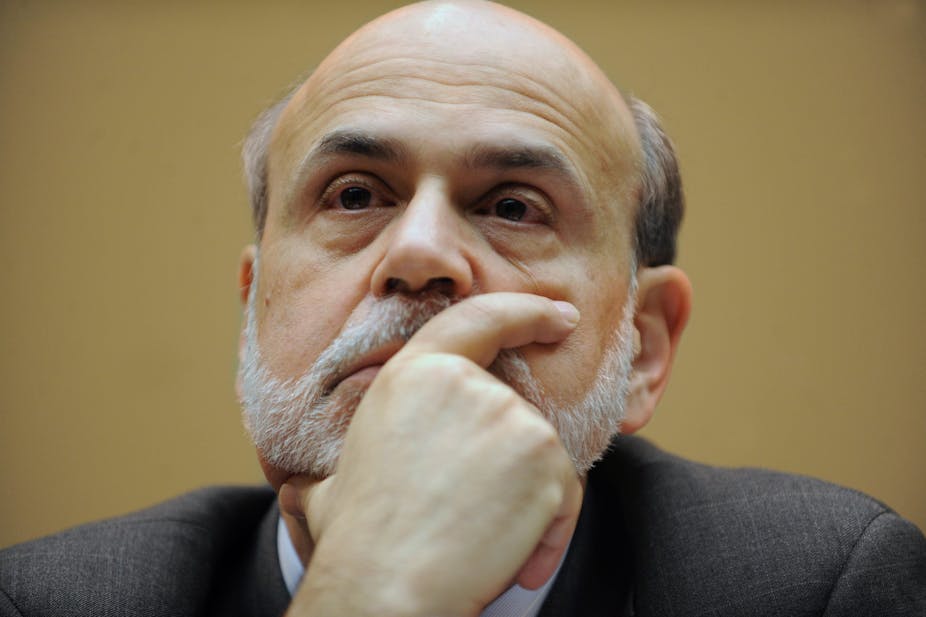Finding bright spots in the US economy is a seemingly thankless task. The unemployment rate, despite dipping slightly in previous months, remains above 8%; last month, employers could only add 96,000 jobs to payrolls, well below economists’ forecasts of 125,000 jobs.
There’s no doubt that these figures weighed on the mind of Federal Reserve chairman Ben Bernanke when he announced a third round of quantitative easing last night.
QE3 will see the Federal Reserve buy $85 billion in new assets — including $40 billion in mortgage-backed securities each month — until the end of the year. But more significantly, this commitment to bond-buying will be open-ended; the Fed has said it will continue to buy assets if the economic situation does not improve markedly. It is a fairly extraordinary intervention — but will it work?
Professor Geoffrey Garrett, CEO of the United States Studies Centre and the Dean of the University of Sydney Business School, shares his thoughts on Bernanke’s bold move.
We’ve seen that previous attempts at quantitative easing in the US — QE 2 and Operation Twist — have had no substantial effects on output or employment growth. Do you think the current economic conditions have merited a third round of quantitative easing? Will this round be any different?
Yes. We have to remember that the US Federal Reserve has a dual mandate. Like other central banks, it has to be concerned about inflation, but it also has a growth mandate. What the Fed is saying is that economic recovery in the US — despite all the work the Fed has done, all the red ink on the government budget — still hasn’t turned around the growth picture enough to reduce the unemployment rate. So yes — justified.
Isn’t there another issue here — namely that of fiscal policy? Surely the fiscal cliff presents a significant hurdle to recovery.
Very important point. Let’s talk about that in two elements.
Firstly, just contrast the Federal Reserve’s position to that of the European Central Bank. The ECB has said that its loose monetary policy must be coupled with tight fiscal policy in member countries — Greece, Spain and the like.
What Ben Bernanke said last week at Jackson Hole and what his behaviour today speaks volumes to is the endorsement of Obama’s fiscal policy. This decision says that now is not the time to tighten. Of course, the debt in the long run must be solved, but now is not the time to tighten. In this sense, the Fed are accommodating the government.
What does that accommodation mean and why do we think it might work? What Bernanke said today was really to focus on the housing market. Doubling the Federal Reserve’s purchases of mortgage-backed securities is designed to drive down interest rates in the US, more than they currently are, understanding how critical the housing market has always been to the US economy.
Bernanke also flagged that if these measures were not enough, he will do more. The “more” he’s talking about is more direct Federal Reserve buying of US Treasury bonds. Essentially, that is the Federal Reserve underwriting the US government’s debt. That’s where the US is today, and I think it is just so different from the situation in Europe, where central banks are only willing to do monetary easing where there is credible evidence of fiscal austerity. The US doesn’t look like that.
But if the Federal Reserve expands its balance sheet, will it mean a more complicated exit strategy? Will there be less flexibility for it to act in case of future shocks?
Two responses to that. The first one is: I think the Fed believes that it must act now and deal with the future in the future. Secondly, the thing that is distinctive about the US — and we’ve now seen this for several years — is that unlike Greece, Spain, Italy, or France, the global capital market is still willing to underwrite at US government debt at incredibly low interest rates. Last time I looked, the ten-year T-bill is trading at under 2%. The world capital market is saying that US government debt is still the gold standard asset.

